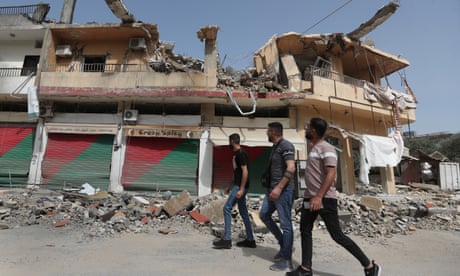
Yoav Gallant, Israel’s defence minister, described the conflict Israel was engaged in as a “multi-front war” earlier this month.
Israeli forces were fighting Hamas inside Gaza and engaged in daily exchanges of fire with Hezbollah on the northern border with Lebanon. A low-level conflict, mainly consisting of airstrikes, was continuing with Iranian-backed forces in Syria. Israel had also been targeted – albeit ineffectively – by drones fired by the Houthis in Yemen.
But the date of Gallant’s comments was significant. He was speaking on 2 April, the day after Israel had bombed an Iranian diplomatic facility in the Syrian capital, Damascus. Within a fortnight, Israel would add another front to Gallant’s multi-front conflict after Iran launched 300 missiles and drones at Israel in retaliation for that attack.
While Israel has been here before – not least in 1967 and 1973, when it fought wars with conventional Arab armies pressing from several directions – this conflict, or series of interrelated conflicts, is very different. The opening of a new front with Iran raises serious new questions, and not just about whether the country has the capacity to fight multiple adversaries in what – for now at least – appears to be an open-ended state of conflict.
The reality is that while Israel has planned for at least a decade for a war that might involve simultaneously fighting in Gaza and against Hezbollah in the north, the assumptions about how that campaign would be conducted appear to have been mistaken.
The key organising concept for the Israel Defense Forces’ strategy in recent years has been the Momentum Multiyear Plan. That plan’s starting point was the idea that Israel was highly unlikely to have to fight conventional ground forces, as it once did in the six-day and Yom Kippur wars. Based on its experiences from the second Lebanon war in 2006 and previous conflicts in Gaza, the IDF concluded that its primary foes would be “diffuse, rocket-based terror armies.”
While militarily inferior, these would neither be simple militant or guerrilla-like groups, but advanced, well-trained and ideologically motivated adversaries, operating in complex and sometimes connected networks.
The “operational concept of victory” the planners settled on in this scenario was one that envisaged Israel fighting small wars smartly, decisively and quickly.
Six months on since Hamas’s surprise attack on southern Israel on 7 October, which killed more than 1,100 people, the notion that Tel Aviv is fighting a small war decisively and quickly has been seriously exposed.
Far from being totally dismantled, as Israel’s leaders promised, Hamas in Gaza is damaged but still in existence, with many of its most senior leaders apparently alive and with Israel’s campaign bogged down and lacking clear objectives.
The huge level of destruction and loss of civilian life also suggests that the war has been far from smart.
On the northern border, daily exchanges of fire with a far more powerful force, Hezbollah, has driven Israel to evacuate civilians. Most Israeli military planners now concede Hezbollah could inflict serious damage in a full-blown conflict.
And then there is the threat from Iran, which became the first country since Saddam Hussein’s Iraq more than three decades ago to target Israeli soil directly.
Speaking to Foreign Policy magazine in the immediate aftermath of 7 October, the former IDF intelligence chief Tamir Hayman foresaw some of the challenges Israel would face fighting a multi-front war.
“We can handle more than one front. We can handle even three fronts. The military decision, victory, will not be simultaneous, but that’s no problem,” he said. “We can finish one and move to another; we have enough capabilities that can do that.
“The problem,” Hayman suggested, “is not the IDF; the problem is the home front. The problem is the damage to Israeli society and the resilience of Israeli society. Two fronts is not a military problem. It’s a social, resilience, and home-front defence problem.”
The debate over whether Israel can fight on the multiple fronts it is now faced with has increasingly become a moot one, not least as it has become clear how significant an international coalition of countries was in helping confront the Iranian missile strike last week.
Without that quickly assembled coalition, the consequences of Iran’s attack might have been markedly different to what transpired – which was presented as a victory.
Instead, the issue for Israel is that while it was correct to anticipate the networked nature of the conflicts it might confront, the actual reality of fighting them has been more confounding and more draining on resources, both military and social.
The way that Israel has fought since 7 October has corroded and depleted its international support.
Even as its allies were stepping up to help it defend itself against Iran, the US and Europe were drawing up new sanctions to punish extremist settlers, with every indication that there are more to come.
In a messy and metastasising conflict, whose objectives have become ever more unclear, observers are no longer asking whether Israel has the capacity to fight on multiple fronts. Instead, the question is: to what purpose does it do so? And at what ultimate cost?